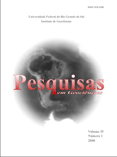Depósitos de Fluxo Piroclástico Primários: Caracterização e Estudo de um Caso no Vulcanismo Ácido Neoproterozóico do Escudo Sul-rio-grandense
DOI:
https://doi.org/10.22456/1807-9806.19576Palavras-chave:
pyroclastic deposits, ignimbrites, Neoproterozoic acid volcanism, Sul-rio-grandense Shield.Resumo
Volcanic deposits can be included in two main groups: coherent and volcaniclastic. The former results from volcanic and sub-volcanic (syn-volcanic intrusions) effusive events, excluding autoclastic portions, and the second group, which is related to deposits constituted by volcanic fragments, encompassing primary deposits (pyroclastic) generated from fragment dispersion through gases and hot vapour, syn-eruptive resedimented deposits, besides volcanogenic sedimentary deposits. Clast transport processes are separated in three broad categories: mass-flow, traction and suspension. Basic concepts that are used in the study of volcanic rocks, classification and characterization of the main subaerial pyroclastic deposits are discussed in this paper, considering lithological and genetic aspects. Lithological aspects are mainly related to composition, components and grain-size of the deposits, while genetic aspects and interpretations are based on clast-forming and depositional processes, allowing understanding about eruption and emplacement conditions. Emphasis is given to pumiceous pyroclastic flow deposits, describing their main textural features and the post-depositional modifications associated to them. The discussed concepts are applied in the reconstruction of the Neoproterozoic pyroclastic flow deposits of two plateaus in the Sul-rio-grandense Shield, southernmost Brazil. The main characteristic of the Taquarembo Plateau is the occurrence of stratified/partially welded ignimbrites and high-grade welded deposits, while massive and crystal-rich ignimbrites are more common in the Ramada Plateau. The facies association of both plateaus suggests a fissural volcanic regime in a subaerial setting, associated to the post-collisional stages of the Brasiliano-Pan African Orogenic Cicle.



